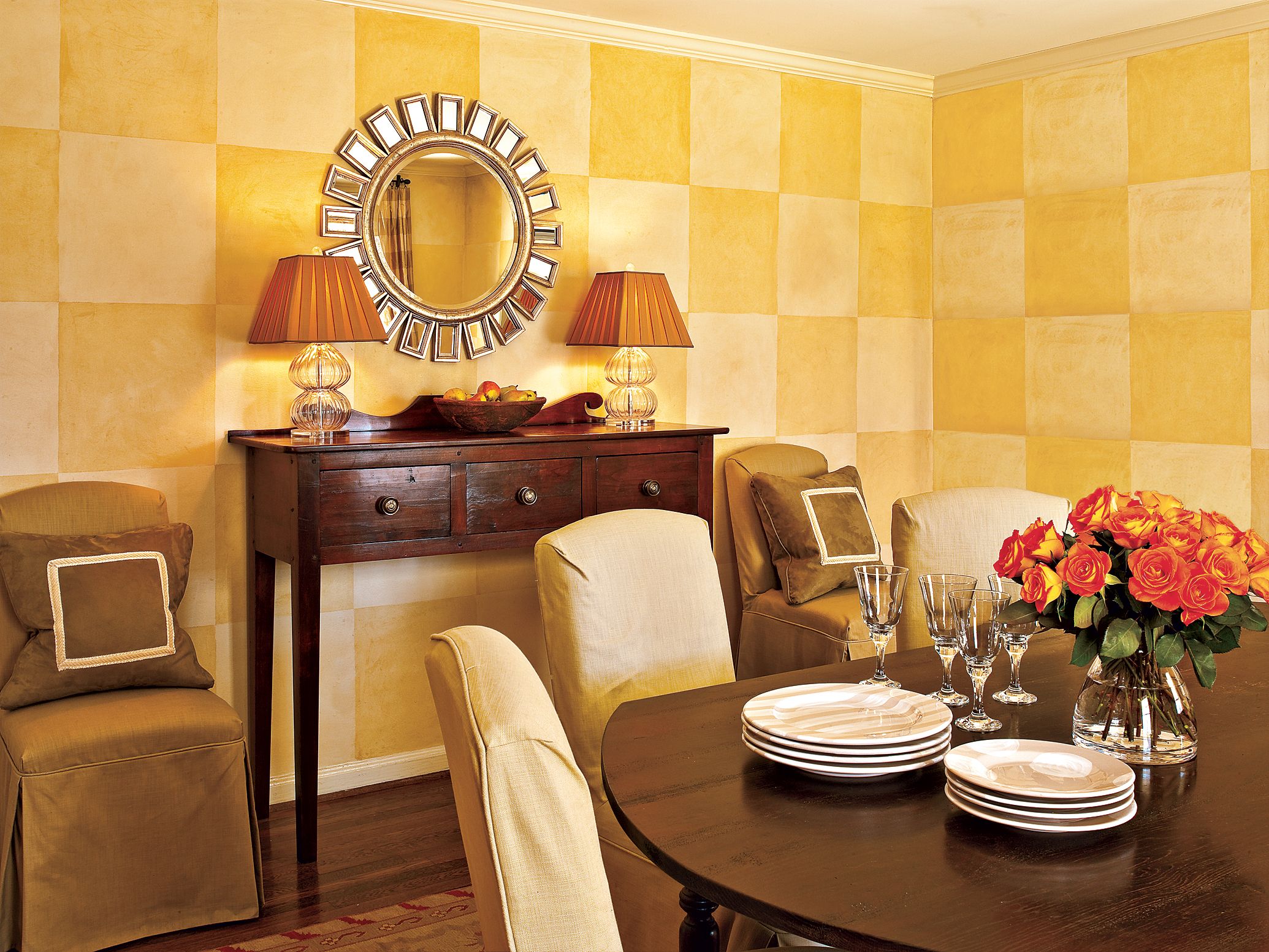Painting is a quick and affordable way to breathe new life into your home. From creative kitchen wall designs to adding visual interest in bathrooms, let these decorative painting ideas inspire your next home decor project.
1. Paint a Colorful Patchwork Floor
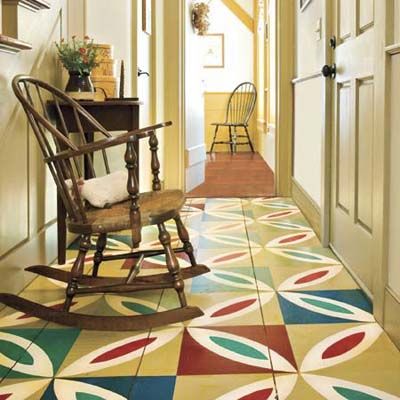
Transform a dull foyer into a stunning focal point with leftover paint and a creative vision. This patchwork floor design adds personality, character, and charm to any entryway. To create this look, homeowners Arlene and Seth Perlmutter followed these steps:
- Clean the floor thoroughly.
- Tape off uniform squares, allowing partial squares at thresholds.
- Paint the majority of squares the same color as the walls.
- Use different shades for remaining squares in a semi-random pattern.
- Add white elongated petals using a hand-cut Mylar stencil.
- Apply a protective top coat.
This unique floor design can withstand foot traffic and pets while adding a personalized touch to your home—without the need for expensive materials.
2. Roll On Faux Bricks
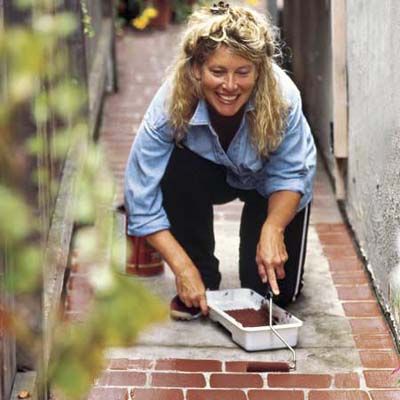
Create the illusion of a brick walkway without the hefty price tag of natural stone or cast pavers. This painting technique can give your concrete path a fresh, inviting face-lift:
- Sweep and clean the surface thoroughly.
- Prime with a concrete resurfacer for a smooth base. Let it dry completely.
- Use a 4-inch roller to create “bricks” with terra-cotta-hued concrete paint.
- Paint a border along both sides of the path for a finished look.
- Fill the space between with a running bond pattern of 8-inch bricks.
Don’t worry about perfect lines or exact sizes—imperfections add to the realistic appearance.
3. Add Drama with an Oversized Pattern
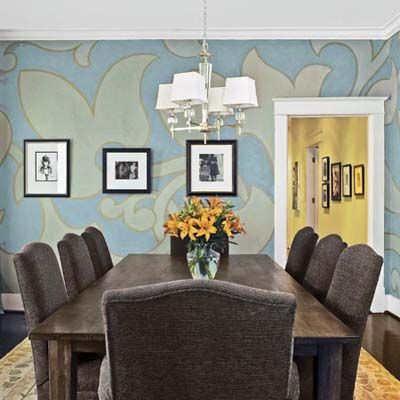
For a unique and personal touch, consider creating an oversized floral pattern on your walls. This technique works particularly well in dining rooms or small powder rooms where a dramatic effect is desired. Here’s how decorative painter Brian Carter achieved this look:
- Find a swirly floral wallpaper pattern for inspiration.
- Simplify the design by tracing only the largest shapes to avoid overwhelming the space.
- Transfer the drawing to the walls, increasing the scale dramatically.
- Use a chalk line to create a grid on the walls for guidance.
- Paint the design using regular interior latex paint and an artist’s round brush.
This whimsical effect adds personality and creates a one-of-a-kind space in your home.
4. Enlarge a Bath with Sideways Stripes
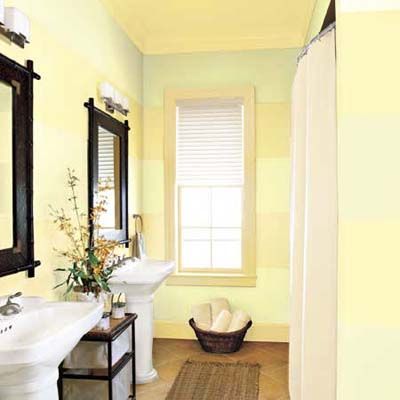
Contrary to popular belief, wide horizontal stripes can make a small bathroom appear bigger. “[These stripes] appear to ‘push out’ the walls, making the room look larger,” says Debbie Zimmer, a color expert at the Paint Quality Institute. Follow these tips to create this optical illusion:
- Choose two closely related hues to maintain cohesion.
- Apply the lighter color as the base coat.
- Measure the wall height and divide by five to determine stripe height. (If you end up with an awkward fraction, add a little extra to the top and bottom bands to round off the number.)
- Mark and tape off the stripes using a level for precision.
- Paint alternating stripes with the deeper color.
- Add black accents to give the pale colors a sophisticated edge.
This technique can dramatically change the perception of space in your bathroom, making it feel more open and airy.
5. Take Notes with a Chalkboard Calendar
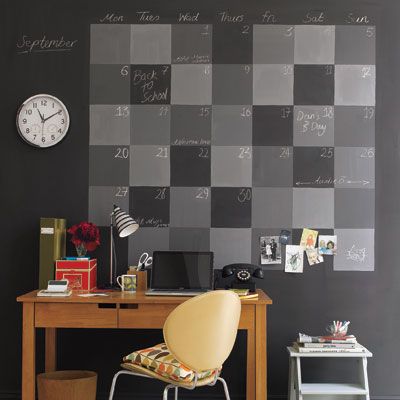
This versatile chalkboard paint design allows for easy updates and customization, perfect for busy households. The hardest part is coordinating the taping: After you paint the first set of squares, pull up the tape, wait a day, and put down a new line of tape to do the next set.
To start, apply a base coat of standard gray chalkboard paint. Draw squares in pencil and tape them off neatly. Fill in three-quarters of the squares with different shades of light and medium gray for contrast, leaving the remaining squares the same color as the wall to break the pattern. When you’re done, allow the paint to cure for a couple days before use.
6. Bring Walls to Life with Tiny Twigs
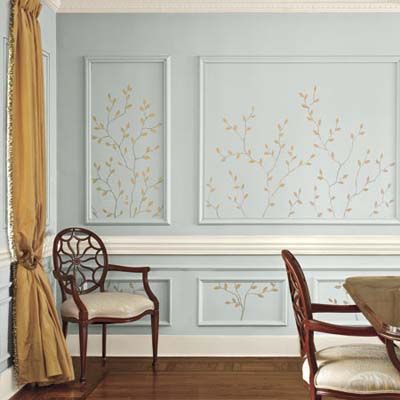
Add a touch of nature to your interior walls with a delicate twig design. Interior designer Meridy King originally painted this paneled dining room a soft French blue with linen-white baseboards and chair rail. But something was still missing, so she turned to Carter for the finishing touch. The solution came in the form of gentle tree branches, a natural motif for a room with a garden view.
Follow these steps to get the look:
- Paint the walls a soft color, such as King’s French blue.
- Use baseboards and chair rail to frame the design.
- Sketch gentle tree branches growing up from the floor.
- Paint the branches using a natural, organic approach.
- Allow leaves to bump against wall moldings for a framed effect.
This subtle yet impactful design adds depth and interest.
7. Check the Walls with Tone-On-Tone Color
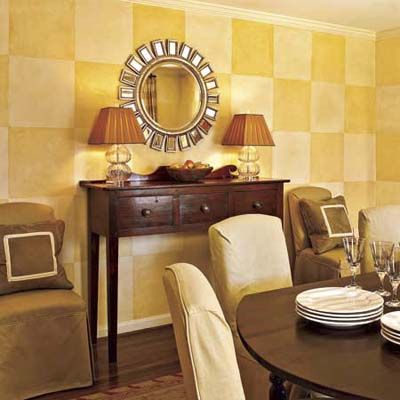
Carter creates a warm and inviting atmosphere with a tone-on-tone checkered wall design. Here’s how to achieve this look:
- Paint the walls a creamy beige base color for a neutral canvas.
- Apply two shades of tinted glaze to create 17-inch squares.
- Paint alternating squares with a darker glaze mixture for contrast.
- Lightly paint the entire surface with a third, lighter glaze mixture for a cohesive finish.
This subtle pattern adds sophistication and warmth without being overwhelming.
8. Make Odd Seats Look Like a Set
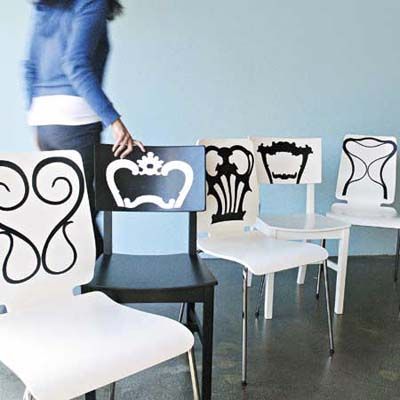
Unify mismatched chairs for dinner parties and gatherings with a coat of paint and decorative decals. This technique creates a creative yet cohesive look for your dining area:
- Choose chairs with flat backs for the best results.
- Clean and sand the chair surfaces to prepare for painting.
- Apply a base coat of paint in your desired color to unify the pieces.
- Add decorative decals for a charming touch.
- Seal the design with a clear protective coat for durability.
9. Use Stamps for Visual Interest
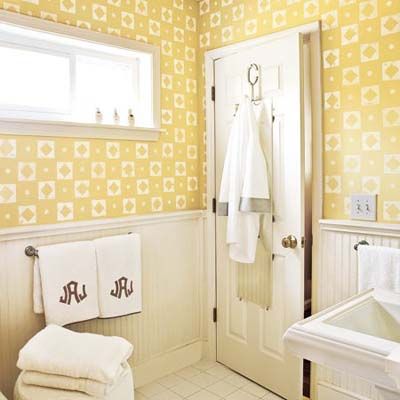
Carter suggests using homemade stamps to create a wall pattern for a unique, handcrafted look. This technique adds texture and personality to any room and can be easily customized to fit your style:
- Make stamps using flexible craft foam and scrap wood.
- Choose a base coat color and a contrasting color for the pattern.
- Apply the base coat and let it dry completely.
- Stamp the pattern at regular intervals across the wall.
- Add smaller details between the main stamped elements for complexity.
View the complete step-by-step instructions at How to Create a Stamped Wall Design.
10. Glaze On a Bamboo Grove
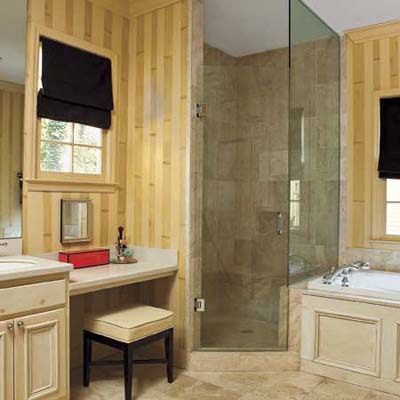
Bamboo has been a popular design motif since the 18th century. But Carter had a fresher, cleaner look in mind when he updated this beige bath. This technique creates a serene and natural atmosphere, perfect for relaxation:
- Use painter’s tape to create two- to four-inch-wide vertical stripes for the bamboo stalks. “Make the stripes different widths for the most natural look,” Carter suggests.
- Paint the stripes in varying shades of beige or green to mimic natural bamboo.
- Apply glaze in sections to create the bamboo effect. Use overlapping brush marks to suggest bamboo nodes.
11. Pick a Pairing To Add a Blast of Color

Mark Chamberlain, a decorative painter and colorist in New York City, suggests energizing your space by pairing complementary colors from the color wheel. This technique can update traditional rooms or add vibrancy to contemporary spaces, depending on your color choices:
- Choose two neighboring colors on the color wheel for a cohesive look.
- Select a warm hue and a cool hue for balance and vibrancy.
- Use brighter colors for a contemporary look or softer hues for a conservative approach.
- Apply the colors to opposite walls or use wainscoting to divide them for visual interest.
- Balance bold colors with neutral furnishings and accessories to avoid overwhelming the space.
12. Paint a Checkered Floor Design
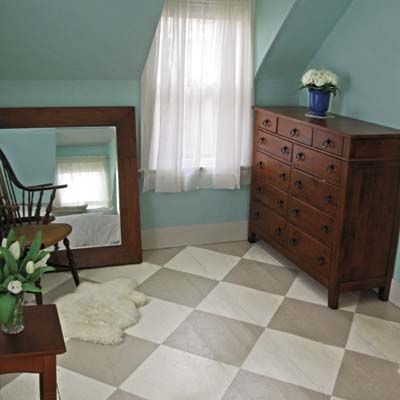
Transform a plain wood floor with a painted checkered pattern, like Sara and Andrew Taylor did in their Massachusetts farmhouse. This Old House senior technical editor Mark Powers also used these techniques to create a similar floor in his own house.
This painted floor works well in bedrooms, sunrooms, or enclosed porches, adding a unique and stylish element to your home. View the complete step-by-step instructions at How to Paint a Floor.
13. Use Leftovers To Add Charming Details
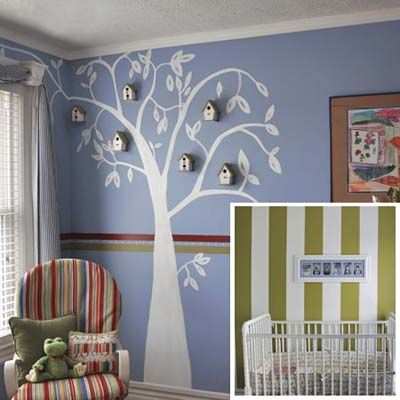
Get creative with leftover paint to add unique details to a room. This approach is perfect for nurseries or children’s rooms:
- Sketch your design in chalk on the wall for guidance. Stephany Kropman did this for her tree mural: “If you don’t like it, you just wipe and redo.”
- Use leftover paint colors to create a focal wall or mural.
- Add dimension with decorative elements.
- Incorporate stripes or polka dots for additional interest.
- Tie the design together with coordinating colors on adjacent walls.
14. Paint Candy-Coated Wainscot Stripes
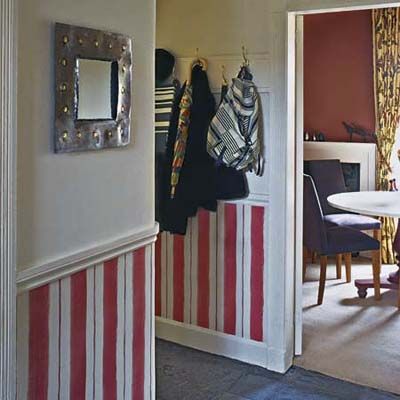
Candy-coated wainscot stripes create a dimensional look on your walls. Start with a neutral base coat for a balanced look, then choose a secondary color for the stripes to create contrast. New York City-based decorative painter Alison Shapiro suggests outlining the stripes using a pencil, ruler, and plumb line for precision. Roll on wide stripes and add pinstripes with a small brush for detail. Mix the stripe color with latex glaze for a translucent effect.
This decorative painting idea works well in dining rooms, entryways, or powder rooms, adding a sophisticated touch to your decor.
15. Spruce Up Stairways With Carpetless Runners
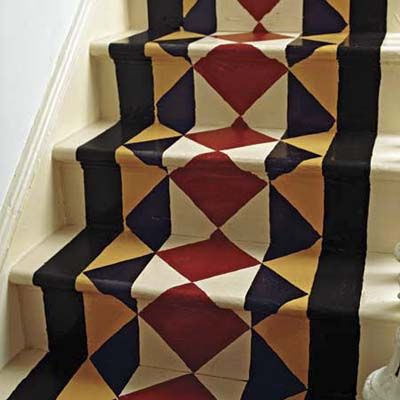
Create the illusion of a runner on your stairs without the expense of carpet. This painted runner adds visual interest and is easy to maintain.
If you start with ivory-painted stairs, you’ll only need to add a few more details. Add two black stripes and two yellow stripes for contrast, then create a pattern of triangles and squares using templates. Paint the shapes using a stencil brush for clean edges and protect the design with polyurethane coats for durability.
